Authors: Nicole Wellbrock (Thünen Institute), Vera Makowski (Thünen Institute), Raisa Mäkipää (Natural Resources Institute Finland), Aleksi Lehtonen (Natural Resources Institute Finland)
Forests cover approximately 40 % of the EU’s total land area, and forest soils play a crucial role in ecosystem processes and the global economy by delivering essential ecosystem services. In Europe, for all land uses, there are 30-40 soil types, and hundreds of sub-categories exist.
European forests grow on a wide variety of soils and under various conditions. Compared to arable soils, forest soils tend to be stonier, less fertile, affected by waterlogging and they are often located on steeper slopes. Forest soils are not disturbed by annual tillage and harvest, and their management usually takes decades to centuries. For this reason, soils under forests have different physical and chemical properties and biogeochemical dynamics compared to adjacent agricultural soils. Forests typically develop an organic surface layer (the forest floor).
Forest soils store much more organic matter than agricultural soils in 1 meter depth, which is why forests play a crucial role in the European soil carbon balance and related climate change mitigation measures in the EU. Organic soils like peatlands have the highest carbon content, but when they are drained, those carbon pools turn into a carbon source. The forest floor is a biological hotspot, affecting the carbon-, water- and nutrient dynamics of forest soil and of the whole forest ecosystem (Dise et al. 1998). Current research is focusing on generating a better understanding of the interaction of soil properties and biodiversity in soils.
Around 33 % of soils worldwide are already degraded. Forest soil health is influenced by a range of natural and human-induced factors, which differ significantly from those affecting soils under other land uses. In forest ecosystems, soil health varies depending on regional conditions, levels of pollution, climate patterns, and forest management practices. Human-induced nitrogen deposition, heavy metals and acid rain also have long-lasting effects to soils, e.g., extreme pollution from the second half of the 20th century is still clearly visible in forest soil properties in some European regions (Ulrich et al. 1991; Thimonier et al. 2019).
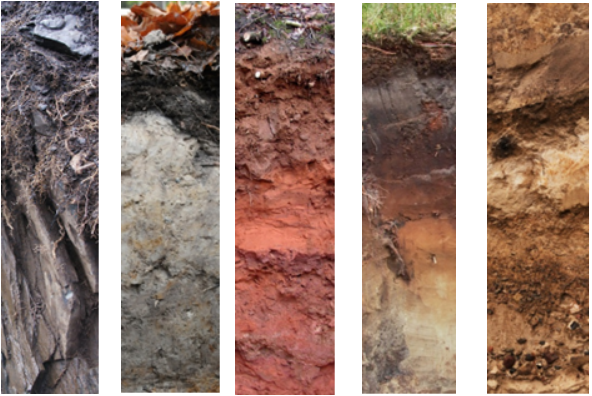
Why do we monitor forest soils?
Healthy soils provide many ecosystem functions:
- Carbon storage and greenhouse gases regulation
- provisioning of clean water
- Provision of raw materials
- Filtering of nutrients and contaminants
- Temperature regulation
- Biodiversity pool, such as habitats, species and genes
- Recreation
Soil monitoring is important due to changing environmental conditions like climate change, atmospheric deposition and forest management. Therefore, it is important to generate reliable data and provide forecasts for the future. Besides national soil surveys, two large-scale soil monitoring systems exist in Europe: EU LUCAS monitoring (since 2015) and the UNECE ICP Forests (since 1990). The focus and number of plots of both systems differ slightly.
Some EU regulations like the LULUCF regulation, the NEC directive or the nature restoration law require monitoring of soil C stocks or soils indicators, while the EU soil monitoring law focuses on multiple soil variables. To meet all those goals, thresholds for healthy soils for different indicators and land uses will have to be developed, together with guidelines for sustainable land use for healthy soils. What is needed to monitor forest soils in contrast to agricultural soils is explained further in Wellbrock et al. (2024).
How are forest soils sampled?
Typically, different field teams or laboratories use their specific field- and laboratory guidelines to sample forest soils, as currently no harmonised methodologies, guidance and field training are available. They would, however be required to ensure that monitoring teams produce comparable results.
Choosing the correct sampling tool for different soils and the forest floor
The best way of sampling the forest floor is by using a frame (e.g. 20 x 20 cm2). The litter layer and other organic material is not stored very densely and therefore need to be sampled carefully and undisturbed. A well-developed organic layer, like mor (e.g. in boreal forests) can also be sampled using a soil auger.
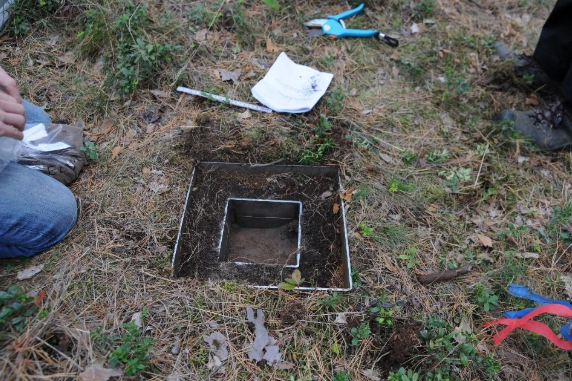
Mineral soils (less than 12 % organic C content, not water-saturated over the year) can be sampled by different augers with different diameters for chemical analysis. For bulk density measurement (which is needed to calculate carbon stocks) a core with a specified volume (e.g. 100 cm3) is used. (see Figure 3).
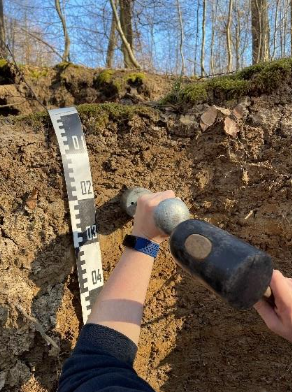
Organic soils (for example in peatlands) are often very wet and fluid and the normal auger that is used with upland soils does not work. Therefore, a so-called Russian auger will be used, which is closed, and the organic material will stay inside until the auger is opened. (see Figure 4).
To measure emissions like carbon dioxide (CO2) , nitrous oxide (N2O) and methan (CH4) from organic soils, different methods can be used.
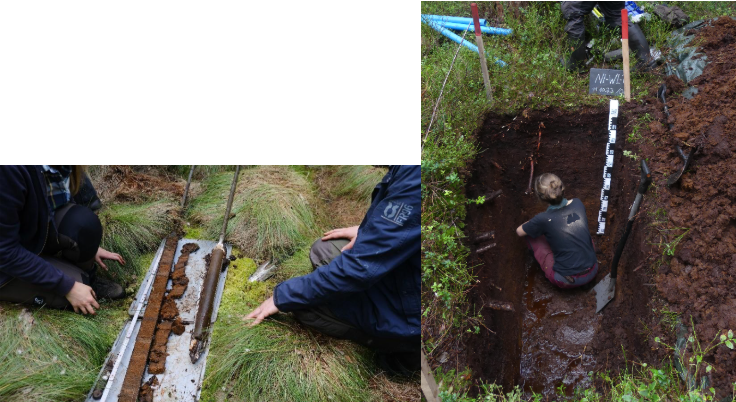
The principles of plot and sampling design
A representative inventory design is essential to ensure that large-scale monitoring plots cover all kinds of soil types, climate zones, geology and forest types. Only then can reliable statements about the area (region, country, the EU) one wants to look at be made. The higher the resolution of the area to be monitored, the more sample points are required to reach the desired certainty of the estimates. For example, ICP Forests uses a 16 x 16 km grid in a European-wide forest soil sampling to generate European-wide results. A systematic sampling grid like those used in the UNECE ICP Forests or LUCAS inventories are a way of representing all environmental circumstances in the EU.
Forest soils and especially forest floors vary within centimetres, horizontally and vertically (Muukkonen et al. 2009). For that reason, the sampling design should consider the small-scale heterogeneity through sampling at a minimum of 5 samples per depth. Soils vary also considerably with depth, because soil development leads to different horizons with different properties. For this reason, soils sampling should consider sampling strategies that provide samples from different soil depths (e.g. 0-5cm,10-30cm, 60-90cm). (Fig. 5)
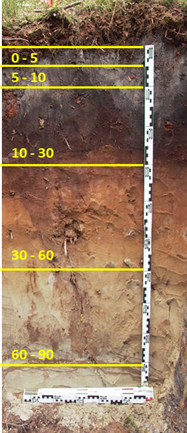
Since long-term monitoring is intended to report changes in the soil condition and properties, it is important to collect repeated forest soil samples at the same place with a design rotation. Due to the high small-scale variability of forest soils and the aim to produce reliable statistical outputs, exact sampling is particularly relevant. For this reason, in addition to the coordinates, fixed markings in the soil are needed to be able to collect samples at the same place years later. It remains very difficult to reliably detect changes because soils are changing slowly.
Due to long rotation periods, soil and forest management practices have long-term impact which require longer periods of monitoring and evaluation. To generate reliable data for less frequent (10–15 years) monitoring surveys many more plots have to be sampled which becomes financially and resource-wise more challenging (Mäkipää et al. 2008).
Using indicators to assess forest soils functions and threats
Due to soil and forest management, pollution or climate change, the function of soils can be impaired or lost completely. Those threats and potential changes can be monitored with the help of a set of different indicators that are listed below:
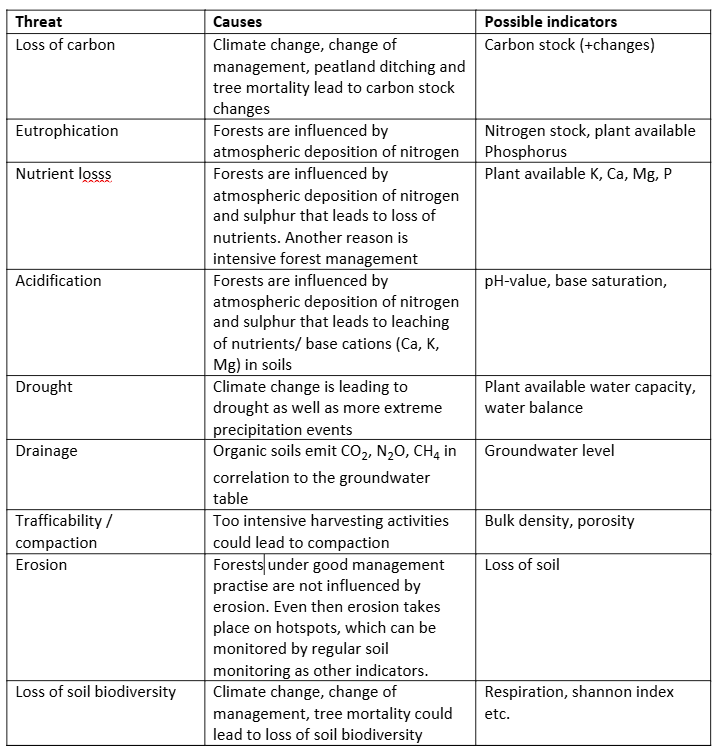
References
Dise N.B., Matzner E., Forsius C. 1998 Evaluation of organic horizon C: N ratio as an indicator of nitrate leaching in conifer forests across Europe’. Environ Pollut 102:453–456
Muukkonen, P., Häkkinen, M. & Mäkipää, R. 2009. Spatial variation in soil carbon in the organic layer of boreal forest soil – implications for sampling design. Environmental Monitoring and Assessment, 158: 67-76. https://doi.org/10.1007/s10661-008-0565-2
Mäkipää, R., Häkkinen, M., Muukkonen, P. & Peltoniemi, M. 2008. The costs of monitoring changes in forest soil carbon stocks. Boreal Environment Research, 13 (suppl. B): 120-130. http://urn.fi/URN:NBN:fi-fe2016083123310
Thimonier A., Kosonen Z., Braun S., Rihm B., Schleppi P., Schmitt M. 2019. Total deposition of nitrogen in Swiss forests: Comparison of assessment methods and evaluation of changes over two decades. Atmos Environ 198:335–350. https://doi.org/10.1016/j.atmosenv.2018.10.051
Ulrich B. 1991. An Ecosystem Approach to Soil Acidification. In: Ulrich, B., Sumner, M.E. (eds) Soil Acidity. Springer, Berlin, Heidelberg. https://doi.org/10.1007/978-3-642-74442-6_3
Wellbrock, N., Cools, N., Vos, B., Jandl, R., Lehtonen, A., Leitgeb, E., Mäkipää, R., Pavlenda, P., Schwärtzel, K., Srámek, V. 2024. There is a need to better take into account forest soils in the planned soil monitoring law of the European Union. Annals of Forest Science. 81. https://doi.org/10.1186/s13595-024-01238-7